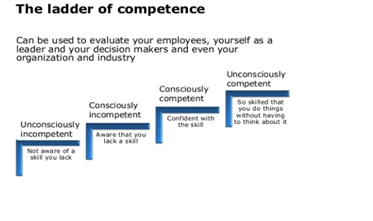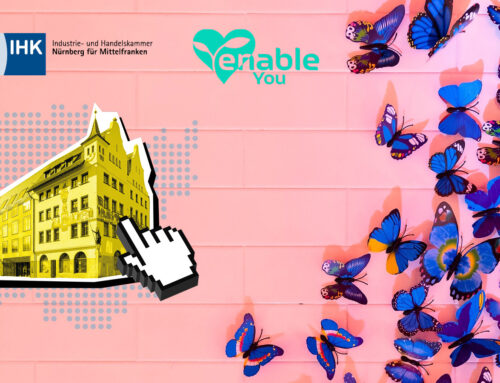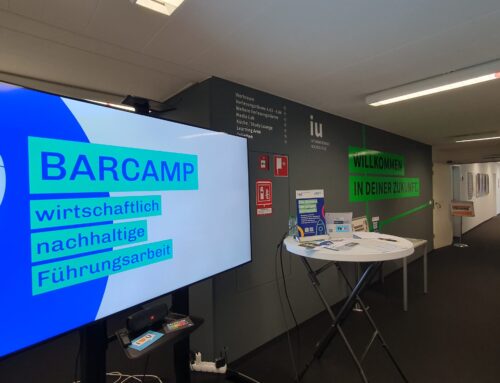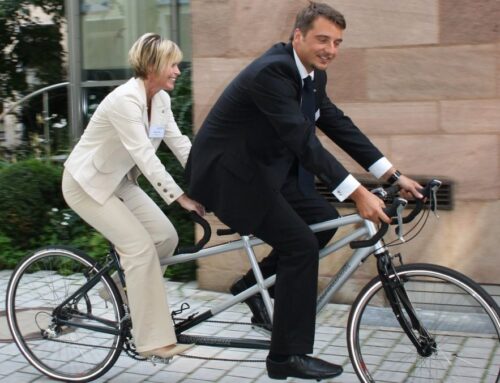In these unstable and uncertain times, we need to look at the things that unite us. Leading from the emerging female future. Homo Ecologicus. The new human being. The unconditional global co-creator. Better Business. Better World.
When I read Frederic Laloux’s book “Reinventing Organizations” I could totally connect to what he writes about human development and evolution. We are, as humankind, developing to a higher level of consciousness. He uses the model of value based personal, team, organizational and societal development developed by Richard Barrett. A model which is in its simplicity brilliant and so easy to understand. But. And there is a huge but. There is something they are unconsciously incompetent and unconscious biased about. In the language of Richard Barret in his 7 levels of personal evolutionary transformation, the potential for human growth lies in the alignment of the ego and the soul. What is it that Laloux and Barrett don’t get? And how do we get management to change?” Doing more of what does not work won’t make it work any better.
The Barrett Model for exploring your ego-soul balance and how to live your core values
The Seven Levels Model describes the evolutionary development of human consciousness. The Seven Levels Model was developed in 1996–1997. There are two aspects to the model—the Seven Levels of Consciousness Model and the Seven Stages of Psychological Development Model. We operate at levels of consciousness and we grow in stages (of psychological development). The Seven Levels of Consciousness Model applies to all individuals and human group structures—organisations, communities, nations. The Seven Levels of Psychological Development Model applies to all individuals. The following diagram shows the correspondence between the Seven Levels of Consciousness and the Seven Stages of Psychological Development.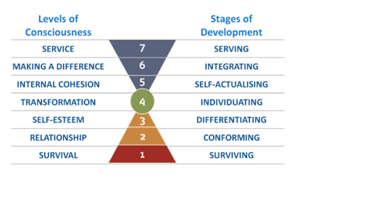
Under normal circumstances, the level of consciousness we operate from is the same as the stage of psychological development we have reached. However, no matter what stage of psychological development we are at, when we are faced with what we consider to be a potentially negative change in our circumstances or a situation that we believe could threaten our internal stability or external equilibrium—anything that brings up fear—we may temporarily shift to one of the three lower levels of consciousness. Alternatively, if we have a “peak” experience—an experience of euphoria, harmony or connectedness of a mystical or spiritual nature— we may temporarily “jump” to a higher level of consciousness. When the threat or peak experience has passed, we will normally return to the level of consciousness that corresponds to the stage of psychological development we were at before the experience occurred. In rare situations, a peak experience may have a lasting impact, causing us to shift to a higher stage of psychological development and operate from a higher level of consciousness. Similarly, a “negative” experience, if it is traumatic enough, and particularly if it occurs in our childhood and teenage years, can impede our future psychological development by causing us to be anchored, through frequent triggering of the traumatic memory, into in one of the three lower levels of consciousness.
Try the link to this free Personal Value Assessment:
https://www.valuescentre.com/tools-assessments/pva/
Now let us look at the history of leadership:
The history of leadership is based on a male masculine patriarchal authoritarian hierarchical left brain thinking based on individual merits. In such a culture there is and was little room for the feminine qualities, values, and traits. On the contrary. In every leadership education and development, it is the support of the ego needs that are being reinforced according to Barbara Kellermann at Harvard University. Instead, we should focus on issues of gender and power and the way certain behaviours “get disappeared”. Not because they are ineffective, but because they are associated with the feminine, relational, or so-called soft skills. Due to the cultural impact I have mentioned, these implicit associations with the feminine tend to code these behaviours as inappropriate to the workplace because they are out of line with some deeply held, gender linked assumptions about good workers, exemplary behaviour and successful organizations. In other words, we can assume there is a masculine logic of effectiveness operating in organizations that is accepted as so natural and right that it may seem odd to call them masculine. I must admit that even I am stunned by my own blindness not to see the enormous opportunity to lead from the emerging feminine foreseeable future. Welcome to this big club of being unconsciously incompetent. You could think it is the best kept secret in the World! It is the ridiculous rare corporation that takes the advantage of the women’s opportunity. What a costly mistake.
Why men should get engaged in accelerating female leadership and how can your organisation do to successfully accelerate female leadership?
Frederic Laloux refers to another worldwide Gallup survey revealing that only 13 % of workers are engaged in work. The vast majority say they are not motivated, while 24 % are actively dissatisfied with their workplace” This proves that the current hierarchical organization chart is ripe for the evolutionary scrap heap. Throughout human history, we have taken highly necessary leaps from tribal organization to rural communities, and on to industrial and gradually the information society. Now we face the fifth leap, the consciousness leap. When Laloux describes qualities of Teal consciousness he refers to female values, traits and femininity and here are some examples:
- Is highly sensitive to people feelings
- All perspectives deserve equal respect
- It seeks fairness, equality, harmony, community, cooperation and consensus
- The autonomous self-operating: from this perspective strives to belong, to foster close and harmonious bonds with everyone.
- We often value the masculine above the feminine; we have lost community and our innate connection with nature
- With this stage comes a deep yearning for wholeness – bringing together the ego and the deeper parts of self: integrating mind, body and soul; cultivating both the feminine and masculine parts within; being whole in relation to others; and repairing our broken relationship with life and nature
- The feminine part of the self – the caring, questioning, inviting – are often neglected or dismissed
- Future organizations need significant training in relational skills.
- Focus on team performance (women are much better than men on this. They are far more collectively intelligent and diverse teams perform better due to having a coherent set of skills and techniques for healthy and efficient group decision making creating outrageous results)
- Is guided by intuition and beauty
- Focuses on what is the right thing one ought to do
- Traditional top down hierarchical authoritarian organizations require showing a masculine resolve. Not only masculine. Mono masculine. It is only the masculine values and traits that count. The mono masculine patriarchal values.
- Long – term strategies should according to Laloux be 10 years.
- Capacity to think complexity
- Involve the top management in the role of the sponsor, which is crucial for the implementations and the long-term effects
- Strategically implement a gender policy defining how and why it’s done and also its goals
- Identify, consciously create and utilize career codes for both, women and men
- Base gender projects on factual and relevant challenges for the company for a mutual benefit
- Align all activities in the program with the strategic goals and ethical standards of the organisation
- Review frame conditions for appropriate adjustments to the needs of both genders
- Support the alikeness of women and men as well as their differences
- Enhance interaction between women and men
- Create a broad commitment and gender-overall team spirit
I assume that you agree with me that these values, traits and qualities are the glue that will hold an organization together? How can you bring your personal leadership style to your workplace? What would it be like to be part of a working culture, a working democracy, in your organization?
As you can see from the above-mentioned values, traits and qualities, they are mostly all from notes which I took when reading Frederic Laloux’s book “Reinventing Organizations” In my world these are all female. I asked myself the question: it is so obvious that they are female! So how come that both Laloux and Barrett don’t mention that? After having read books by both, I wrote to Laloux and asked him if he was aware of this fact. I got the answer that he did not have the time to answer. However, shortly after he published an illustrated version of “Reinventing Organizations” where he has a short chapter about the masculine and feminine. A coincidence? Maybe. Or maybe not. If you look at this competence model
both Laloux and Barrett are in my mind, unconsciously incompetent about the feminine as I have described over in the history of leadership. The traditional organizational culture is based on male masculine authoritarian hierarchical patriarchal left brain thinking and individual merits by default. In this cultural environment the feminine simply disappears because it is not appreciated. We can for sure say this is contradictory to what an organization needs. The female qualities are the glue that holds an organization together and is essential for the organization to reach its goals.
“Goodbye,“ said the fox. „And now here is my secret, a very simple secret: It is only with the heart that one can see rightly; what is essential is invisible to the eye.”
Author:
Christopher Weber-Fürst
Strategic futurist expert leading from the emerging female future. Executive coach
Unternehmen: FemaleFuture. Better business.Better world.
post@coaching-fuerst.de


